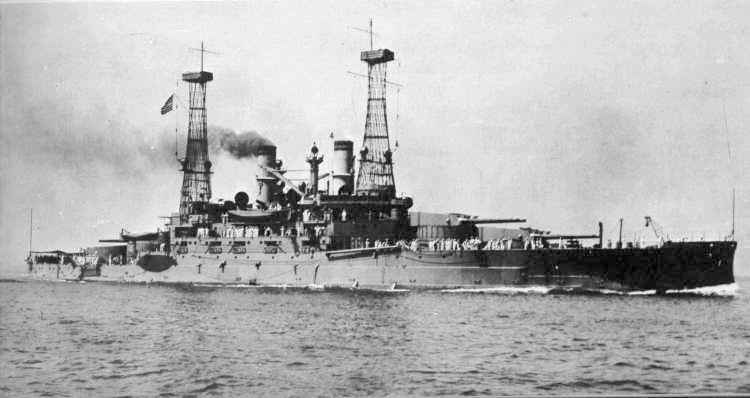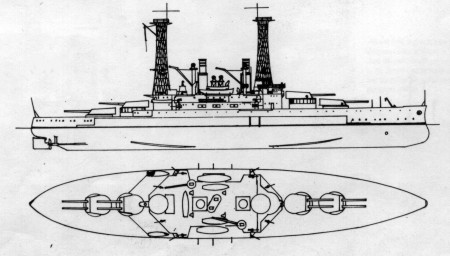

USS South Carolina
Lattice masts, superimposed turrets, the heavy piled effects amidships, and secondary armament mounted in casemates distinguish this highly economical American "First Generation Dreadnought".
SPECIFICATIONS
Displacement: 16,000 tons (normal), 17,900 tons (full load)
Dimensions: 450 ft length x 80 ft 3 in beam
Guns: 8x12 inch 45cal (4x2); 22x3 inch 50cal (22x1); reduced to 14x3 inch 50 cal 1917; 2x3 inch A.A. added 1917; 4x1 pounders (4x1)
Torpedo Tubes: 2x21 inch (beam. submerged)
Armor: Main belt 12-9 inch
SOUTH CAROLINA CLASS
| Ship | Laid Down | Launched | Completed | Built By |
| BB-26 South Carolina | 18 December 1906 | 11 July 1908 | March 1910 | Cramp |
| BB-27 Michigan | 17 December 1906 | 26 May 1908 | January 1910 | New York Shipbuilding |
General: These two ships were precursors of the Dreadnought, and were in fact the first 'all big-gun' battleships in the world. With the Lord Nelsons, the Japanese Aki and Satsuma and other contemporaries, they were the outcome of the increasing efficiency of long-range gunnery. The Russo-Japanese War having proved that naval battles would be fought at ranges of 7000 yards and more, it was logical to increase the volume of long-range fire in order to make ranging by salvoes possible.
Had approval of the naval appropriations not been delayed, and had the Royal Navy not been able to build the Dreadnought in a year, the Michigan or the South Carolina might have given their name to a new type of battleship, for they embodied a huge jump in offensive power. Their chief virtue lay in the logical layout of the armament--all the main guns on the centreline with the inner turrets superfiring. This meant that they had the same broadside as the Dreadnought, but without the penalty imposed by having wing turrets, thus doing away with the need for a fifth gun position. On the other hand, the U.S. Navy was not able to gamble on the Parsons turbine, and the conventional reciprocating machinery was retained. Like the Dreadnought herself, reliance was placed on a large battery of very light guns for defense against torpedo-craft. These guns were placed a deck higher than in other American ships of the same era, with obvious advantages in rough weather.
The displacement of this class had been restricted by Congress to 16,000 tons. As valuable weight had been devoted to the superimposed 12in guns, it was necessary to compensate for this elsewhere. As a result the freeboard aft was reduced to 10 feet, being equivalent to the loss of height of one deck when compared to the Dreadnought.
Armament: The approximate arc of fire for all guns was 270*. Before the ships were laid down experiments had been carried out with a 12 inch gun fired over the turret of a monitor. This had proved conclusively that blast would not interfere unduly with the lower turret, but in this the U.S.Navy was lucky in having turrets with the sighting hoods at the rear. Other navies, particularly the British, had turrets with sighting hoods at the front, which meant that superimposed guns could not fire straight ahead.
Appearance: The silhouette of these two ships was unique, with prominent caps on the funnels, two 'basket' masts, and the secondary battery at forecastle deck level between the turrets. In 1917-18 both carried two 3 inch anti-aircraft guns on the crowns of the after derrick-posts (replacing searchlights).
Careers
Michigan: Served with Atlantic Fleet on outbreak of war, and attached to Battleship Force II; refitted at Philadelphia Navy Yard July 1917 and then served on training duties in Chesapeake Bay; refitted once more August-September 1918 and returned to training duties until February 1919; sailed for France as transport 4 February 1919 and repatriated soldiers until July; stricken 17 October 1923 and scrapped at Philadelphia Navy Yard in 1924.
South Carolina: Following a refit at Philadelphia Navy Yard completed January 1917, served in Guantanamo Bay area until outbreak of war; April 1917 became gunnery training ship in Chesapeake Bay area; left Tompkinsville, N.Y. as unit of the ocean escort for a troop convoy in September 1918, and returned a week later for repairs; returned to gunnery training duties in the York River until the Armistice; served as troop transport from February to July 1919, making four runs between Hampton Roads and Brest and carrying 4500 soldiers; Annapolis midshipmen's cruise to Pacific 1920, and to West Indies and foreign ports 1921; paid off at Philadelphia Navy Yard 15 December 1921; stricken 13 January 1924 and scrapped.

SOURCE:
Last Updated 24 December 1999

